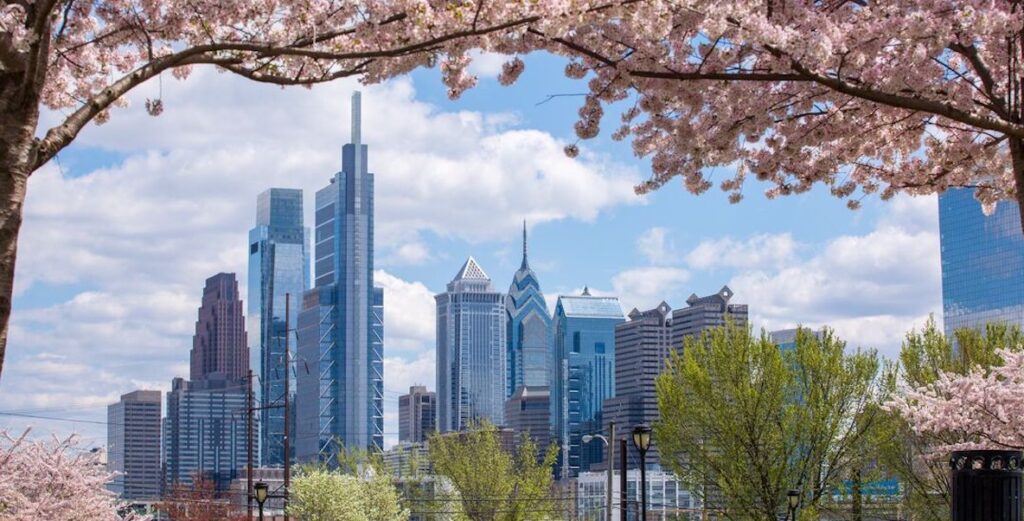The 2023 mayor’s race presents a significant opportunity for residents to collectively determine the direction of our city in the years ahead. We call on the next mayor to recognize the strong connection between greening and environmental justice, and racial, health, and neighborhood equity and safety and the economy as defined by communities.
Our coalition of 13 local organizations united to produce the Green Living Plan for Philadelphia: An Action Agenda for Creating Healthier, Safer, and More Environmentally Equitable Neighborhoods, a city-wide, community-driven agenda that outlines environmentally focused and neighborhood-based policy, programmatic, and investment solutions for Philadelphia’s most pressing quality of life challenges.
The issues highlighted during months of outreach to residents informed the priority areas and action items contained in this report. We heard that neighborhood quality of life and the environment that people call home are increasingly seen as vital to their health and well-being. We also heard, and recognize, that Philadelphians are already experiencing increasingly negative impacts from climate change. Communities of color and low-income communities are disproportionately impacted due to generations of disinvestment because of historically racist practices like redlining.
These issues have real consequences. Philadelphia sits in one of the most polluted metro areas in the United States. More than 20 percent of the city’s children have asthma, which is more than double the normal rate. Neighborhoods with lower tree canopy cover are correlated with higher crime, even after accounting for neighborhood privilege. There is a 22-degree difference between the hottest and coolest neighborhoods in Philadelphia, which can lead to severe illness and death in vulnerable communities. We have a higher percentage of polluted waters than any other county in Pennsylvania.
Our vision
Though the city has made some strides in these areas, far more must be done to build on efforts to clean our air and water and provide clean and green neighborhoods. Solutions must have both immediate and long-term impacts. Philadelphia’s next Mayor must possess the ability to make progress on long-term problems of air and water pollution, as well as newer threats posed by the consequences from warmer and wetter weather. The Mayor must also provide our neighborhoods with more green space and cleaner streets as a safety and economic imperative.
We understand and appreciate that investments in urban environmental quality can give rise to concerns related to gentrification, green gentrification, and displacement. We believe that the communities of color and low-income communities that have been disproportionately impacted by harmful socioeconomic and environmental policies must enjoy the benefit of investment in their neighborhoods without fear of being forced to leave due to rising costs.
Though generally outside of the scope of this effort, we urge Philadelphia’s next Mayor and City Council to improve access to affordable housing in addition to the recommendations contained in this report. We believe that Philadelphia can be clean and green, and that these traits are fundamental to a healthy and equitable city.
Tremendous opportunities exist to create change due to historic investments from the federal government (through Infrastructure Investment and Jobs Act and the Inflation Reduction Act) to enable just climate transition and the foundational work that city government has completed to arrive at this defining moment. There is a real desire in neighborhoods across the city to chart a new path forward. The Green Living Plan provides a roadmap to assist our next Mayor in charting that new path that now been endorsed by 60 organizations.
Investment Principles
In addressing the challenges highlighted above, we must ensure that city resources are focused on the neighborhoods with the greatest socio-economic disparities. People in low-income neighborhoods must have a higher level of investment and attention than more affluent Philadelphia neighborhoods. Newly focused investment must also come with plans for how to include, not displace, people in neighborhoods.
To do this, the Green Living Plan recommends that the next Mayor adopts the following principles when making investment and resource-allocation decisions:
-
- Commit to establishing a decision-making methodology to ensure that resources are allocated to the neighborhoods with the greatest needs;
- Apply and deploy city, state, and federal funding in alignment with the developed methodology;
- Create an executive level position to provide transparent oversight of departmental execution of policies and programs, with input from the Environmental Justice Advisory Commission;
- Develop a communication mechanism to ensure transparency, regular public reporting and opportunities for feedback.
With technical assistance provided by The Academy of Natural Sciences of Drexel University, with the support of The Environmental Collaboratory, we have identified priority community geographic areas at the zip code level with the highest environmental and public health disparities. The Geographic information system mapping was completed based on the Academy’s environmental justice index and other social, economic, and health factors to provide the next Mayor with a roadmap for investment, policy and program prioritization based on The Green Living Plan. The maps and data can be viewed here.
Green Living Plan Priority Areas and Action Items
The Green Living Plan is centered around five environmental priority areas that together impact neighborhood health, equity, and quality of life. These priorities are:
-
- Address air pollution and heat islands
- Invest in, protect, and maintain green and public spaces
- Build a pipeline of high-quality green jobs
- Improve basic “clean & green” service delivery and enforcement
- Accelerate efforts to reduce water pollution
Each of the priority areas includes specific policy, programmatic, and budgetary action steps are within the next Mayor’s power to create a safer, healthier, and environmentally equitable Philadelphia.
For more detail on the plan, go here.
The Green Living Plan coalition consists of: The Academy of Natural Sciences of Drexel University, Cedar Park Neighbors, The Environmental Collaboratory at Drexel University (technical advisor), Esperanza, Mantua Civic Association, Overbrook Environmental Education Center, PennFuture (co-coordinator), Pennsylvania Horticultural Society (co-coordinator), POWER Interfaith Climate, Justice & Jobs, Public Health Management Corporation, SEAMAAC, Trust for Public Land, and Young Chances Foundation.

